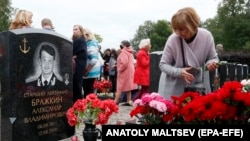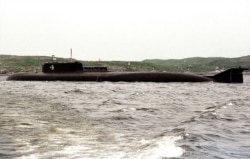On November 22, Russia’s RIA Novosti state news agency published an interview with Vyacheslav Popov, the former admiral of Russia’s Northern Fleet, about the disastrous sinking of the Kursk submarine, which occurred during his tenure in August 2000.
Popov’s rehashing of this conspiracy theory comes as Russia-NATO relations have hit a new low. Apart from tensions over Russia’s actions in and around Ukraine since 2014, Russia’s ally Belarus has set off a crisis with its neighbors Lithuania and Poland by attempting to push migrants across the other countries’ borders. Meanwhile, as many as 100,000 Russian troops have been deployed near the borders of Ukraine with no stated purpose or scheduled exercise to explain the presence.
Popov claimed the Russian nuclear-powered submarine sank in the Barents Sea after colliding with a NATO submarine belonging either to the United States Navy or the British Royal Navy.
"The submarine which collided with the Kursk was following the Kursk, apparently, but was unable to ensure safety in those sea conditions and all other conditions, it got too close, or the Kursk's maneuvering led to a loss of contact,” Popov told RIA Novosti.
“I know the name of it with a 90% probability, but in order to publicly name it, you need to have evidence and lay it out. I can't lay it out. A NATO submarine. And it was there, in the area where it collided with the Kursk."
That claim is false.
A Russian government investigation found in 2002 that the Kursk was sunk by a catastrophic explosion that occurred when propellent from a faulty torpedo ignited, setting off other torpedoes stored in the sub’s bow, following an accident that occurred during a major Russian naval exercise.
All 118 crew members aboard were killed.
Popov admitted he has no evidence for his theory, while the RIA Novosti story acknowledged that Russia’s own official version does not blame the sinking of the Kursk on a collision.
“According to the official version of a Russian government commission, announced in July 2002, the Kursk nuclear submarine was lost as a result of a thermal explosion of the fuel components of a 65-76 torpedo, which led to a subsequent detonation,” the RIA Novosti article noted.
The disaster, which took place during Vladimir Putin’s first year as Russia’s president, became a scandal after it was revealed that it took officials several hours to confirm the sub’s disappearance and that offers of help from the United Kingdom and Norway were rejected.
In addition, when Putin met with relatives of the lost crew members, some of them charged that the fleet had mishandled the rescue operation and criticized the lack of transparency about what had happened.
Popov’s theories are not new: he and other Russian officials have floated these claims since 2000. Moreover, Russia’s Navy was accused of initially downplaying the situation, and Popov allegedly waited hours before ordering a search for the missing sub. Popov has claimed that one of three NATO subs that were observing Russian naval exercises at the time of the Kursk disaster -- the USS Toledo and USS Memphis of the U.S. Navy and the Royal Navy’s HMS Splendid -- might have been responsible for it.
There is no evidence that any of the three subs sustained the kind of damage that would be expected from a collision. However, Popov, along with other supporters of the collision theory, complained that the U.S. refused to let the Russians inspect the subs.
Other evidence contradicts Popov’s and similar claims. The Blacknest seismic monitoring station based in Berkshire, U.K., picked up the double explosion aboard the Kursk on the day of the disaster. It detected no sound of a collision prior to the first distinct explosion. Other seismologists backed those findings.
What is more, a similar incident occurred on the HMS Sidon, a Royal Navy sub, in 1955, due to the same cause -- the ignition of a torpedo’s High Test Peroxide (HTP). Only in the Kursk’s case, the HTP fire managed to set off several live torpedoes.
A salvage operation that Russia conducted with the help of Dutch companies may have made it impossible to verify the collision theory. The Kursk’s torpedo section was detached from the rest of the wreckage, which was refloated. Citing a potential danger to fishing vessels and other craft, the remains of the torpedo section were then destroyed.
Kremlin spokesman Dmitry Peskov weighed in on the renewed controversy on November 22, backing the government’s official version of what happened to the Kursk.
"[There are] no comments,” Russia’s TASS state news agency quoted him as saying. “You know that there was a probe. The investigation made its final conclusion, and therefore we do not want to comment on the emergence of any other theories here.”






